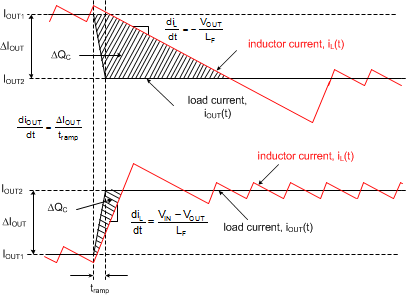ZHCSNB5B June 2021 – February 2025 LM25148-Q1
PRODUCTION DATA
- 1
- 1 特性
- 2 应用
- 3 说明
- 4 说明(续)
- 5 可订购器件型号
- 6 引脚配置和功能
- 7 规格
-
8 详细说明
- 8.1 概述
- 8.2 功能方框图
- 8.3
特性说明
- 8.3.1 输入电压范围 (VIN)
- 8.3.2 高压偏置电源稳压器(VCC、VCCX、VDDA)
- 8.3.3 精密使能端 (EN)
- 8.3.4 电源正常监视器 (PG)
- 8.3.5 开关频率 (RT)
- 8.3.6 双随机展频 (DRSS)
- 8.3.7 软启动
- 8.3.8 输出电压设定值 (FB)
- 8.3.9 最短可控导通时间
- 8.3.10 误差放大器和 PWM 比较器(FB、EXTCOMP)
- 8.3.11 斜率补偿
- 8.3.12 电感器电流检测(ISNS+、VOUT)
- 8.3.13 断续模式电流限制
- 8.3.14 高侧和低侧栅极驱动器(HO、LO)
- 8.3.15 输出配置 (CNFG)
- 8.3.16 单输出双相运行
- 8.4 器件功能模式
- 9 应用和实施
- 10器件和文档支持
- 11修订历史记录
- 12机械、封装和可订购信息
9.1.1.2 输出电容器
通常,稳压器的输出电容器能量存储与控制环路响应相结合,用于在动态(瞬态)容差规格内维持输出电压的完整性。在电源管理应用中限制输出电容器的常用边界由有限可用 PCB 面积、元件尺寸和厚度以及成本驱动。随着负载阶跃幅度和压摆率增加,电容器寄生效应(等效串联电阻 (ESR) 和等效串联电感 (ESL))优先于对稳压器的负载瞬态响应进行整形。
输出电容器 COUT 会对电感器纹波电流进行滤波,并提供一个电荷库来应对阶跃负载瞬态事件。通常,陶瓷电容器提供极低的 ESR 来减少输出电压纹波和噪声尖峰,而钽电容器和电解电容器以相对紧凑的外形提供大容量电容来应对瞬态负载事件。
根据 ΔVOUT 所表示的峰峰值输出电压纹波静态规格,选择一个大于方程式 15 中所示值的输出电容。

图 9-1 从概念上展示了负载升压和负载降压转换期间的相关电流波形。如图所示,当电感电流增加以与负载瞬态后的新负载电流电平保持一致时,电感电流的大信号压摆率会受到限制。此压摆率限制加剧了输出电容器中的电荷不足,该不足必须在负载升压瞬态期间及之后尽快进行补充。同样,在负载降压瞬态期间以及之后,电感电流的压摆率限制会使输出电容器中的电荷过剩加剧,而这些过剩的电荷必须尽快消耗掉。
 图 9-1 显示 COUT 电荷过剩或不足的负载瞬态响应表示
图 9-1 显示 COUT 电荷过剩或不足的负载瞬态响应表示在 12V 输入到低输出电压(例如 3.3V)的典型稳压器应用中,负载关断瞬变表示最差情况下的输出电压瞬态偏差。在该转换率应用中,稳态占空比约为 28%,而占空比崩溃至零时的大信号电感电流压摆率约为 –VOUT/L。与负载导通瞬态相比,电感电流转换至所需电平需要的时间更长。输出电容器中的过剩电荷会导致输出电压明显过冲。实际上,若要尽快消耗输出电容器上的过剩电荷,电感器电流必须在负载阶跃后降至标称电平以下。在这种情况下,可以方便地采用大输出电容来吸收过剩电荷并尽可能地减少电压过冲。
为了满足此类负载关断瞬态期间的动态输出电压过冲瞬态规格(用 ΔVOVERSHOOT 表示,其中输出电流的阶跃降低由 ΔIOUT 提供),输出电容必须大于以下值:

制造商数据表中作为规格以显式方式或者在阻抗与频率关系曲线中以隐式方式提供了电容器的 ESR。根据类型、尺寸和结构,电解电容器具有很大的 ESR(5mΩ 及以上)以及相对较大的 ESL(5nH 至 20nH)。PCB 迹线也会产生一些寄生电阻和电感。陶瓷输出电容器在开关频率条件下具有低 ESR 和 ESL 贡献度,容性阻抗分量处于主导地位。不过,根据陶瓷电容器的封装和电压额定值,有效电容可能会在施加直流电压时显著下降,具体取决于施加的直流电压和工作温度。
通过忽略方程式 15 中的 ESR 项,可以快速估算出满足输出纹波规格所需的最小陶瓷电容。对于 5V 输出,常见选择是使用两到四个 1206 或 1210 尺寸的 47µF、10V、X7R 电容器。使用方程式 16 来确定是否需要额外的电容才能满足负载关断瞬态过冲规格。
将陶瓷电容器和电解电容器组合在一起的实现方案着重解释了为什么要并联使用化学特性不同但性能互补的电容器。每个电容器的频率响应都是增值性的,每个电容器都在该频率范围的一部分中提供所需的性能。陶瓷电容器具有低 ESR 和 ESL,因此可以提供出色的中频和高频去耦特性,从而尽可能地减少开关频率输出纹波,而电解电容器具有大容量电容,因此可以提供低频储能来应对负载瞬变需求。